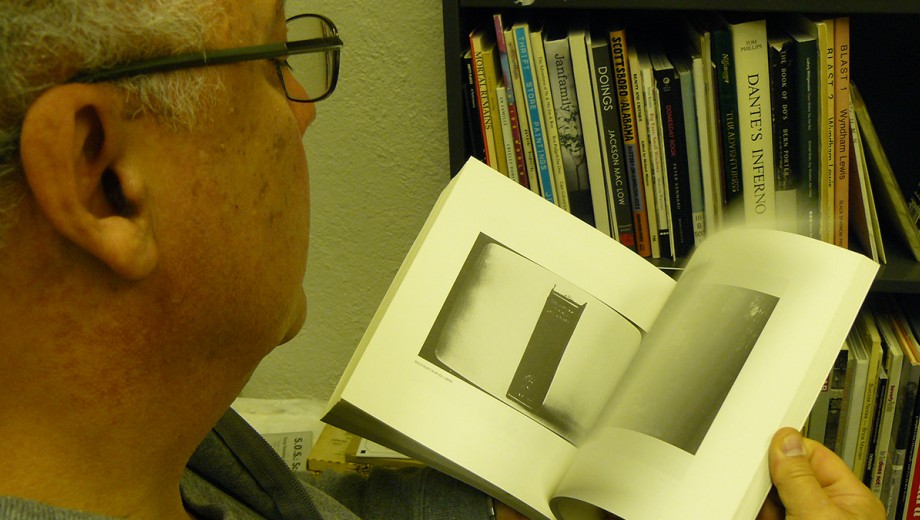Through years of reading, writing, and making books, Buzz Spector, MFA’78, has developed some favorites. He discusses three here:
William H. Gass, In the Heart of the Heart of the Country (David R. Godine, 1968)
I was unfamiliar with Bill Gass when I bought his book in December 1974 at the old Barnes & Noble Bookstore at 19th Street and Fifth Avenue, just across the street from the business meeting that had brought me to New York for my first visit. I had 30 extra minutes between the end of the meeting and the arrival of the car to take me to the airport, and picked up the book from a sale rack. A minute or two into browsing the title story, I was sufficiently enthralled to buy it. Later, reading it all the way through, I was astounded and transformed by the quality of its writing, its uncanny attentiveness to place, and the rigor of its treatment of consciousness. In 1992 I met Bill Gass when we were both speakers at a symposium at the Getty on the future of the book. He was aware of my work as an artist and asked to visit my studio. At the end of that one-hour visit I pulled out my copy of In the Heart of the Heart of the Country and asked if he wouldn’t mind autographing it. He signed and added a sentence about my art that remains the most eloquent summation of my method I have ever received: “For Buzz Spector, who undoes a book the way we all wish to undo the buttons of our beloved.”
Editor’s Note: Gass and Spector have been colleagues at Washington University in St. Louis since Spector’s arrival there in 2009.
Susan Stewart, On Longing (Johns Hopkins University Press, 1984)
In the fall of 1988 my wife and I had just moved to the West Coast from Chicago. We were living in Los Angeles, where she had a job, and I was commuting to Santa Barbara, where I was a visiting faculty member at the University of California, Santa Barbara. A young sculpture professor, Ann Hamilton, had a room for rent, and I needed a place to stay three nights a week. This was the start of our friendship of now 28 years. Ann and I had our own book club for two, and the volume that occupied us most deeply was Stewart’s critical analysis of the ways in which material objects stand in for larger relationships of makers, owners, and the world. We talked our way almost page by page through Stewart’s linked essays on miniatures, the gigantic, souvenirs, and collections. The book has nothing to say about contemporary art, but its themes are of sustaining value to artists. Ann subsequently wrote Susan about how much On Longing meant to her, and the friendship between them led to Susan writing a major catalog essay about Ann’s 1991 installation at the Museum of Contemporary Art San Diego. For my part, Susan’s meditations on souvenirs and collections enriched my own subsequent work with libraries and books.
Reagan Upshaw, On the Cape (The Press of Events, 1988)
Is it cheating to include a chapbook written by a friend, which includes artwork of mine, and whose single long poem is addressed to me? On the Cape was a project that Reagan Upshaw, AM’76, and I worked on during a family vacation together on Cape Cod in summer 1987. The vacation suffered somewhat due to Reagan’s and my focus on writing (his) and sketching (mine), but over time our spouses have, for the most part, forgiven us our distraction. In any event, I made many pencil and ink sketches of architectural details, bathers silhouetted against setting sun, beach shells, and a dead skate washed up with the tide. Reagan didn’t share what he was writing longhand in a notebook, and several months passed before the bulky manila envelope arrived in the mail. When I read the typescript of the poem I was moved to tears. It is a testament to love and friendship, but also to writing, artmaking, and time. My sketches of seashells were set aside, and instead I “illustrated” the book with found postcard images of the Cape and a center drawing, adapted from a Piet Mondrian preparatory sketch of his 1915 Pier and Ocean. I issued the chapbook in 1988 through my own publishing venture of the day, The Press of Events. Twenty years later Reagan and I produced a second edition, designed and printed at the Cornell University Press, with a blurb by Carl Dennis.

